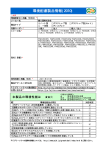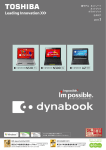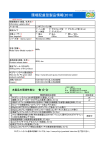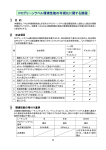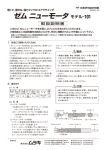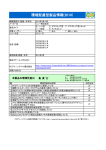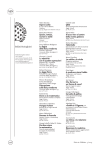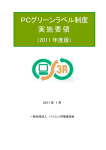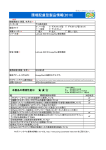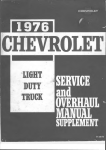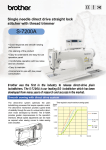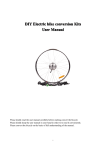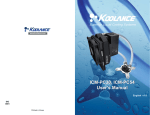Download downloaded - 一般社団法人 パソコン3R推進協会
Transcript
PC Green Label Specification (Ver. 12) This translated document is provided for convenience only, any references to this specification must be based on Japanese version. November, 2011 PC3R Promotion Association Contents 1. Overview 3 2. Administration 5 3. Criteria 8 4. Instructions for filling out Form 1 (Company Examination Ver. 6) 12 5. Instructions for filling out Form 2 (Product Examination Ver. 12) 14 6. Regulation for the “PC Green Label Logo” 20 7. Regulation for the “PC Green Label Environmental performance” 23 Attached documents Company Examination Checklist Ver. 6 (Form 1) Product Examination Checklist Ver. 12 (Form 2) 2 PC Green Label Overview 1 Concept The “PC green label” indicates manufacturer’s overall efforts and activities to ensure that the personal computer is environmentally conscious. The label concept consists of the following three elements: “Environmentally Conscious PC” manufacturers that operate practical environmental management system A B Environmentally Conscious Design and Manufacturing (including 3R). Reuse, Recycling and Proper disposal the end of life. C Disclosure of Product Environmental Profiles. Indicates wide range of environmental initiatives (including 3R) that effect throughout business enterprise system, product design and manufacturing. Self declaration type of label because of product characteristics of short life. Approach to raise environmental standards for the entire industry rather than produce a top runner. 2 Value for Users Disclosure of Environmental information which is helpful for users when selecting (or using) a computer. Environmental Conscious Design and Manufacturing is well conducted and ensures PC users energy saving, safety, etc. Proper treatment must be taken place after taking back discarded products. 3 Position The label indicates the manufacturer’s intent to promote the formation of the recycling society and the fact that the manufacturer has met industry-wide voluntary targets. It is Type II environmental label of the ISO 14020 series. Compliance to the Product Examination Criteria shall be manufacturer’s responsibility and the PC3R Promotion Association (hereinafter referred to as ‘PC3R’) shall assume no responsibility. 4 Applicable Products The label system covers Personal Computer and Display including accessories (keyboard, mouse, remote controller, AC adapter etc.). Note 1) The Personal Computers are classified as Notebook type (including Tablet type), Desktop type and All-in-One type. 2) The label system only applies to products to be distributed in Japan, but can also apply to products for specific users. 3 3) Thin client can also be covered by this label system if the hardware is PC-based and meets all the items of the Company Examination Criteria and the Product Examination Criteria for PC Green Label. 4) Netbook can also be covered by this label system if the distribution system is PC and meets all the items of the Company Examination Criteria and the Product Examination Criteria for PC Green Label. 5) The keyboards, mice, servers and workstations are not applied. 4 PC Green Label Administration 1 Administration Administration of affairs concerns the PC green label is carried out primarily by the "PC Green Label Committee" (hereafter referred to as the “Label Committee”) whose membership includes full member of PC3R. 2 Activities of the Label Committee The Label Committee is in charge of managing and promoting the PC green label system (hereafter referred to as the ‘Label System’). (1) Creation concerning specification ① The examination criteria shall be created by ‘Label Committee’. The Company Examination Criteria, the Product Examination Criteria and the Specification shall be reviewed once every two years. ② The examination includes the company examination and product examination. The both examination determines whether the company and product conforms to the spirit of the ISO 14020 series Type II environmental label by means of the checklist prescribed by the PC manufacturer’s guide. ③ Company examination (a) If any manufacturer which is not a full member of PC3R wishes to use the label system, it should become a member in advance. (b) The manufacturer objectively determines whether the manufacturer meets the criteria of the prescribed checklist (Form 1). All of mandatory items on the checklist must be met. (c) If the examination is passed, the manufacturer must report to the PC Green Label Office of PC3R. Form 1 must be sent by e-mail as PDF file. It is similarly reported when the Form 1 is revised. The purpose of reporting to PC3R is to list on the PC3R Web site “PC Green Label conforming products” the manufacturer name who comply with the Company Examination Criteria. (d) The manufacturers which have reported the results of the Company Examination Criteria to PC3R must market the conforming products based on the Product Examination Criteria. ④ Product examination (a) If the company examination is conformed, the label is basically a self-declared type, so the computer manufacturer can use the logo if he objectively determines that he meets the criteria of the prescribed checklist (Form 2). All of mandatory items on the checklist must be met. (b) The manufacturers which insist compliance with the criteria must do the following without delay: The product that conformed is obliged to observe according to Regulations for the “PC Green Label Logo” and “PC Green Label Environmental performance”. A period of publication in Web site shall be three years after the end of production of the product. Related documents of the conformed type/model must be kept by the computer manufacturer to cope with user’s inquiries. 5 (c) The manufacturer using the logo shall at least specify the following statements at the manufacturer Web site “PC Green Label Conforming Products”. It shall be possible to include the underlined part, as needed. “適合製品の一般社団法人 パソコン3R 推進協会(またはPC3R)が定めるPC グリーン ラベル審査基準との適合性については、当社の責任である。” ⑤ Mission of the committee secretariat (a) The committee secretariat is to create a section on green label system and management in the PC3R Web site to publish the PC Green Label Specification and to serve as a portal to products of each manufacturer that have passed the examination. (b) The committee secretariat must also be able to accept various inquiries from users by e-mail, etc. (c) The committee secretariat places frequently asked questions from manufacturers or users into FAQ format to facilitate dissemination of information. (d) The committee secretariat provides the electronic data of “check lists” for “Company examination” and “Product examination” to the PC3R full members and the Label Committee. (e) PC3R shall keep concerned manufacturers informed by utilizing explanatory meetings, etc. in order to obviate any problem (To be implemented, as appropriate, after the new version is published). It will be explained by a leader of the “Label Committee”. (2) Label system management ① Securing of reliability (a) The manufacturers which insist compliance with the criteria are responsible for the assessment and provision of data required for verifying their self-declared environmental claims. (b) The manufacturers must verify compliance with the criteria by evidences, design documents, audit reports, test reports and other documentation. (c) In the event that user must verify compliance with the criteria, the manufacturer must provide information to the extent necessary in response to any inquiries. ② The following basic stance is taken concerning complaints: (a) Any inquiry, complaint, and claim for damage made to the manufacturer or PC3R regarding a difference from content of the label criteria shall be fully handled by a corresponding manufacturer in its own responsibility. And report the disparity, progress, countermeasure and results in order to speedily remedy the situation to the Label Committee (Free format). In addition, PC3R shall have no responsibility for a difference between the product and the content of the label criteria. (b) The PC3R secretariat may raise important issues of user’s inquiries of the label system to the Label Committee. ③ Regulations for the “PC Green Label Logo” and “PC Green Label Environmental performance” shall be obliged to observe those regulations. (3) Promotion/popularization of label system An effective plan for popularizing and promoting the green label system shall be considered and undertaken in the future. 6 3 Application of the label system The criteria Ver. 12 applies to the products selling from April 1, 2012. Note 1) If the manufacturer intends to continue distribution of the products of the old criteria, it can reapply under the new criteria. It is recommended to apply the latest criteria at all times as green procurement requirements often require that the latest versions of the criteria be applied. 2) The previous 2011 criteria shall apply to products to be sold by the end of March, 2012. 3) It shall be based on the next PC Green Label Specification when this Specification will end. 4 PC3R section responsible for the label system PC3R Promotion Association PC Green Label Office 7 PC Green Label Criteria C-1 Company system to design and manufacture environmentally conscious personal computers (1) Environmental management system ① ISO14001 must be certified or equivalent system must be established. (2) Ozone layer depletive substances ① The substances restricted by the ozone layer preservation law must not be used as a cleaner in the manufacturing process for PC and the field replaceable units. (3) Environmental Design Assessment ① Based on the “Guideline for Environmental Design Assessment of personal computers ” (hereafter referred to as Guideline) specified by Japan Electronics and Information Technology Industries Association (hereafter referred to as the JEITA), the assessment items, standards and method must be clarified for each product’s category. ② Environmental Design Assessment must be conducted before releasing new product to market. Assessment must be focused on 3R (Reduce, Reuse, Recycle). ③ Assessment result must be recorded. (4) System for long use of PC ① Product repair service must be provided for at least five years after the end of production of the product. (5) System of PC taking back and disposing ① Must have a recycling system that conforms to the Law for Promotion of Effective Utilization of Resources and the Waste Management and Public Cleaning Law. The logistics of taking back discarded business/household PCs to transport them to the location(s) where discarded PCs are collected and the controlling all steps in this process (including the recycling facilities) from the beginning to the end of the process must be established. The facilities and/or a system for material recycling, etc must be established. The facilities or sub-contractors of PC recycling system should be implemented EMS (Environmental Management System). The company should inspect the sub-contractors periodically. (including the grasp of actual recycling process) C-2 Environmental information (1) Users ① Information for product safety and contact point(s) for disposal must be indicated on the user’s manual, Web site, etc. ② Information of contact point(s) for repairing and functional upgrading service must be indicated on the user’s manual, Web site, etc. 8 ③ An annual status report of PC taking-back, recycling and disposal must be disclosed. ④ An environmental report or a CSR report must be published regularly. (2) Local governments ① Terms and conditions for discarded household PCs which are gathered by local governments must be disclosed. (3) Maintenance service contractors (departments) ① Information for easy maintenance and repair must be provided to promote long-use of the product. (4) Recycling and disposal contractors (departments) ① Technical and safety information for disassembling and proper disposal of the PC must be provided for recycling process. Especially information of hazardous material(s) contained in the PC(s) must be provided. P-1 Environmental conscious product design and manufacturing process (1)Energy efficiency ① The products must be designed for energy saving. ② Information concerning power consumption, etc. must be given in catalogs, user’s manuals, web site, and/or on the product itself (including AC adapter). (2)Safety handling and electromagnetic noise ① Product Safety must follow JIS C6950, J60950, or equivalent. ② Electromagnetic noise level must comply with the technical requirements specified by VCCI Council. (3)Chemicals that could have a negative impact on health and/or the environment ① The product must be designed to comply with Japanese laws/regulations and managed the chemical substances based on the “Guidelines for the Management of Chemical Substances in Product, (JIG-101)” etc. specified by Japan Green Procurement Survey Standardization Initiative (JGPSSI). ② Plastics parts weighting more than 25g must not contain intentionally added chemicals classified as carcinogens (groups 1 and 2A) by IARC (International Cancer Research Center) and/or they must not contain flame retardant substances/preparations above 0.1% classified as R40/45/46/48, R50/51/53 and R60/61. ③ The products supplies parts, maintenance parts, packaging materials, etc. must not contain substances restricted by the ozone layer preservation law. ④ The specific chemical substances which are Lead, cadmium, hexavalent chromium, mercury, or specific bromide flame retardants (PBB, PBDE) contained in the product (The product complies with must be less than reference percentage contents. Japanese J-Moss green mark and/or EU-RoHS. ) 9 ⑤ Parts with direct and prolonged skin contact must not contain nickel. ⑥ The products must not contain asbestos. ⑦ The products must not contain polychlorinated biphenyl (PCB), polychlorinated terphenyl (PCT). ⑧ The products must not contain short chain chloroparaffins (SCCP) with 10-13 carbon atoms in the chain containing at least 48% per mass of chlorine. ⑨ Halogen must not be added to plastic parts weighting more than 25g and printed circuit boards weighting more than 25g. ⑩ The maximum mercury content per LCD back light is 5mg or free from mercury. ⑪ The chemical substances contained in battery are less than reference percentage content. (Excluding button battery: Cadmium 0.002wt%, Mercury 0.0005wt%, Button battery: Cadmium 0.002wt%, Mercury 2wt%) ⑬ The emission rate of specific volatile organic compounds must be less than the criteria on the JEITA “VOC Emission Rate Specification for Personal Computers” (hereafter referred to as VOC specification). ⑭ Halogenated organic compounds must not be added to plastics used for packaging. The sum of percentage contents of lead, cadmium, hexavalent chromium, and mercury present in packaging or packaging components must not exceed 100ppm by weight. ⑮ User’s manuals must not use chlorine bleached paper. (4)LCA ① Environmental impact at each stages of the product must be assessed by using LCA (Life Cycle Assessment). P-2 3R conscious Design and Manufacturing (1) Design for ‘REDUCE’ ① The products must be designed for material reduction. ② The products must be designed for longer life. (2) Design for ‘REUSE’ ① Reusability of units/parts built in the product must be considered (e.g. HDD, FDD, Display, ODD, Memory, CPU, FAN etc). ② Reusable parts/units can be dismantled easily from the PC. ③ Manufacturing date of reusable parts must be provided. (3) Design for ‘RECYCLE’ ① Following must be considered. (a) To uniform metallic parts materials without influence to function, (b) To avoid surface processed materials which are difficult to recycle, (c) To adopt recyclable plastics. 10 ② Plastics parts weighting 25g or more must be considered to minimize number of materials as much as possible without influence to function. ③ Plastics parts weighting more than 25g must be provided with the marking in accordance with JIS K6899/K6999 and/or ISO 1043/11469 for ease of sorting. ④ The product can be disassembled easily. ⑤ Rechargeable batteries (Battery pack) must be provided with the marking for battery type. In addition they can be removed easily from the product. ⑥ The product must be handled and transported easily when taking back. (4) ‘REDUCE’ and ‘RECYCLE’ of user’s manuals and packaging materials ① User’s manuals must be designed for reduce. ② Packaging materials must be designed for reduce. ③ Packaging materials must be designed for recycling. ④ Used packaging materials must be convenient for collection and transportation. 11 Instructions for Filling out Form 1 (Company Examination Ver. 6) Form 1 supports only the Windows version of Office, so those using other versions of Office must check manually. 1. Checklist (Form 1-2) You must verify compliance of the criteria by item on the checklist and if you meet the criteria completely, fill out the column with “✔”. 2. Commentary C-1 (1) If the manufacturer is certified for ISO 14001 (or equivalent), it is desirable that the manufacturer show a copy of the registration certificate on its Web site or communicate this on its product catalog. C-1 (2) Chemicals restricted by the Law for Ozone Layer Preservation refer to: CFCs, HCFCs, bromomethane, Halon, HBFCs, carbon tetrachloride and 1.1.1- trichloroethane. Substances such as detergents directly used in the part or product manufacturing process are applicable C-1 (4) The manufacturer can fill out “✔” if the preparation of product repair service for at least five years are indicated on the warranty and user’s manual etc. C-1 (5) The manufacturer can fill out “✔” if both or one of following applications concerning PC recycling of business/household PCs have been approved by the government. - [Certification under either the Wide Area Recycling Directive or the Wide Area authorization of the Waste Management and Public Cleaning Law ] - [Approval certificate for Collection, Transport and Disposal under the Waste Management and Public Cleaning Law] The manufacturer can fill out “✔” if conducting periodical review of subcontractor’s recycling processes are indicated on the contract etc. C-2 (1) About ①a, if the safety handling of the product are indicated on the user’s manuals, fill out “✔”. About ①b, if the collection inquiry window and treatment procedures of used PC are published at the Web site, fill out “✔”. About ②, if the repair conditions, upgrade, and the inquiry window are published at the Web site, user’s manuals, fill out “✔”. About ③, if the collection and recycling status for the used PC are published at the Web site, fill out “✔”. About ④ , if the environmental reports are published or the information of the environmental policy and recycling are published at the Web site, fill out “✔”. 12 C-2 (2) The manufacturer can fill out “ ✔” if the proper information (regarding collection conditions) to local governments are published at the Web site, C-2 (3) The manufacturer can fill out “✔” if maintenance manuals (repair manual) are provided to the maintenance section. C-2 (4) About ①, the information enable to the proper treatment is provided for recycler(s) and disposal vendor(s), fill out “ ✔ ”. The information for recycler(s) and disposal contractor(s) should publish at the Web site or provide the documents according to the request. About ②, information of the percentage contents for lead, hexavalent chromium, mercury, and specific bromide flame retardants (PBB, PBDE) are published at the Web site based on「The marking for presence of the specific chemical substances for electrical and electronic equipment (JIS C 0950); J-Moss」, fill out “✔”. 13 Instructions for Filling out Form 2 (Product Examination Ver. 12) Form 2 supports only the Windows version of Office, so those using other versions of Office must check Form 2-1 manually. Based on this result, enter checkmarks (✔) in the "conformance" fields in Form 2-2, and enter the Environmental Performance Rating (such as ★★☆) in the "Environmental Performance" field (cell E15) based on the rating standards. For desktop computer set model which contain display, please examine separate reports for the PC and display segments of the unit. However, for units which are powered by a single power cord and for which separate power consumption measurements are not possible, and All-in-One PC, examine as a single report. The desktop type (set) fits this definition. 1. Checklist (Form 2-1) (1) The mandatory items of the checklist have to be satisfied (fill out the column with “✔”). The optional items of checklist must be satisfied more than one optional item as well (fill out the column with “✔”). The point items shall be used to evaluate environmental performance, and if the product to be reported conforms to such performance, the item being considered shall be marked with “✔”. (2) Regarding the desktop type (set), each of the main body portion and the display portion needs to comply with the requirements only with regard to the following six items. If there is any item on which one portion complies with the requirements but the other portion does not, then it shall be deemed that such item is not complied with. ① Plastic parts weighting more than 25g are free from halogen. (excluding unit) ② Printed circuit boards weighting more than 25g are free from halogen. (excluding component and unit) ③ The emission rate of specific organic compounds must be less than the criteria on the JEITA “VOC Emission Rate Specification for Personal Computers”. ④ User’s manuals do not use chlorine bleached paper. ⑤ Life Cycle Assessment is being conducted. ⑥ Plastics parts weighting more than 25g avoids surface finish of metal plating. ⑦ Plastics parts weighting more than 25g avoids surface finish of painting, resin coating and UV coating. (3) The input procedure shall be as follows. ① Check the items for “Optional,” “Mandatory,” and “point.” Regarding VOC in Item P-1(3)⑬, check the item for “Compliant” or “Under measurement” or “Not applied.” If you do not check, it shall mean “Noncompliant”. ② Click the “Finalize” button. If “Noncompliant” is indicated on the situation of compliance, it shows that there are unchecked items and the column for a mandatory item that is not input is indicated in pink. Also, when the “Finalize” button has been clicked, necessary data are transferred to Form 2-2. ③ If data for new products are to be prepared by quoting any data that were prepared previously, either of the following methods shall be employed. If part of the data is to be corrected for the same product type, make corrections for such part. However, if the checklist has been corrected, click the “Finalize” button again. When inputting another product type, re-select the product type. This re-selection resets the following non-applicable items for each type, and point items. And so re-input data for these items and click the “Finalize” button. 14 2. Information (Form 2-2) It summarizes information such as the environmental performance of the products. It includes a portion that is indicated automatically based on the results of Form 2-1, and a portion to be input. After Form 2-1 have been filled out, input shall be made for the portion not indicated. Information update date: If any change has been made to the description of Form 2-2, enter a date of update. Series name/model name (model number): series unit & equipment size unit & representative model name (model number) shall be described. If a representative model name (model number) (e.g. PC-AAAA**BB) has been used, an explanation of “**” shall be given in the column for the model name (model number). There are “a, b”, etc. as an alternative plan for “**”. Since Form 2-2 is published, desirably, it should be in one page. However, if the method described above is difficult to apply or when it cannot fit in one page even if you use a smaller font, two pages at a maximum may be accepted. Selling points of the product: Matters related to the environment that are peculiar to the product shall be described. Enquiry: The e-mail address, Web URL, Tel or Fax that can respond to enquiries from outside is desirable. In addition, you should avoid any e-mail address which allows any individual to be identified. 3. Commentary P-1 (1)① ① The definition for off mode and the measurement conditions in off mode power must conform to EU-ErP directive Lot 6. (Ecodesign) (The definition of the off mode for the PC correlates to WOL disabled state and the ACPI system level S5 state) P-1 (1)② ② The equivalent ”Information concerning power consumption, etc.” refers to the explanation of power consumption, energy consumption efficiency and energy saving function. (All of them need not to be described.) P-1 (2)① ① The equivalent standards are IEC60950, UL60950, CSA60950 etc. P-1(2)② ② Fill out “✔”, if the product conforms to VCCI standard. The manufacturer can not make a solicitation of the VCCI conformity in the catalogs etc. if the products are not applied to VCCI Council. P-1 (3)① ① Fill out “✔”, if related laws/regulations are strictly observed (see the reference below) and the “Guidelines for the Management of Chemical Substances in Product, (JIG-101)” is applied to manage the chemical substances. If it makes sure in dome document, such as “purchase specification” and “Confirmation by the manufacturer” that the manufacturer ask to manage the chemical substances, fill out “✔” for the moment. “Laws/regulations” refer to type-1 chemicals specified by the Chemical Examination Law (Law Concerning the Examination and Regulation of Manufacture, etc of Chemical Substances) and the toxic chemicals banned by the Industrial Safety and Health Law. The products do not use the toxic chemical substance that production is prohibited. 15 "Use of substances" refers to which substances are intentionally added to render materials or parts realize a certain performance or function when manufactured. Impurities and chemicals used in the production process, but theoretically not remaining in the parts are not applicable. ”Guidelines for the Management of Chemical Substances in Product, (JIG-101)” can be downloaded from the following URL. http://210.254.215.73/jeita_eps/green/green8-eg.htm P-1 (3)② ② "Plastic parts" refer to plastic parts used as personal computers, displays, keyboard’s casings, internal chassis, display stands, and not to mice, remote controllers, AC adapters, internal units and parts. High polymer materials used as raw materials among specified IARC substances are not applicable. This item does not apply to cadmium, hexavalent chromium, and formaldehyde because P-1(3)④ applies to cadmium and hexavalent chromium and P-1(3)⑬ apply to formaldehyde. If it makes sure in dome document, such as “purchase specification” and “Confirmation by the manufacturer” that the manufacturer avoid purchasing certain chemicals, fill out “✔” for the moment. Refer to the URL below for the IARC http://www.safe.nite.go.jp/english/db.html Refer to the URL below for the Risk Phrases http://eur-lex.europa.eu/LexUriServ/site/en/oj/2004/l_216/l_21620040616en00030310.pdf#search='2004/73/EC' P-1 (3)③ ③ If it makes sure in dome document, such as “purchase specification” and “Confirmation by the manufacturer” that the manufacturer avoid purchasing components which use the Ozone layer depletive substances, fill out “✔”. P-1 (3)④ ④ Refer to the effective Japanese Industrial Standard “The marking for presence of the specific chemical substances for electrical and electronic equipment (JIS C0950)”, the industry guideline and EU-RoHS directive about exemptions and the calculation of percentage contents. P-1 (3)⑤ ⑤ Portions of the PC that are touched for a long period of time when the PC is operated include the palm rest of the notebook PC, the mouse, and the casing and pen for the tablet PC. P-1(3)⑨ ⑨ "Plastic parts" refer to plastic parts used as personal computers, displays, keyboard’s casings, internal chassis, display stands, and not to mice, remote controllers, AC adapters, internal units and parts. "Printed circuit boards" refer to boards without any parts used directly for personal computers, displays, and not to power supplies, HDDs, ODDs, keyboards, mice, remote controllers, and parts. Chlorine and bromine are applicable for halogen. The definition of halogen-free of a printed circuit board shall be that bromine is 900 ppm or less, chlorine is 900 ppm or less, and bromine + chlorine is 1500 ppm or less, as defined by JPCA. Since there is no criteria for plastic parts, the JPCA standard mentioned above or in-house criteria of each company may be used provisionally. 16 P-1 (3)⑬ ⑬ The product which has a largest emission rate at the one type of PC should be selected for measurement considering volume, weight, display size, thermal distribution, material data and so. If the measurement result shows the emission rate less than guideline value, all products at one type of PC can be assumed as to satisfy the requirement. However, in case the result has a little margin to the guideline value, several units should be measured and judged. If the product of which an application was examined as “Under measurement” is later found to be “Compliant” or “Noncompliant”, the manufacturer shall replace, without fail, the Product information considering environment (Form 2-2) which is being disclosed. VOC specification can be downloaded from the following URL http://home.jeita.or.jp/cgi-bin/page/detail.cgi?n=30&ca=14 When the VOC specification is revised, the measuring result by previous version can be used for judgement during 6monthes after it was revised. In addition, the manufacturer shall manage VOC specification version when it made measurements, so that it can respond to any inquiry from the external. 30-inch or larger displays are not applied. However, the manufacture can be based on the VOC specification. P-1 (3)⑭ ⑭ Organic halogen compounds refer to: plastics such as polyvinylchloride, flame retardants for plastic, and foaming agents for plastic. The JPCA standard (bromine is 900 ppm or less, chlorine is 900 ppm or less, and bromine + chlorine is 1500 ppm or less) or in-house criteria of each company may be used provisionally as the criteria of the halogenated organic compounds. P-1 (4)① ① LCA (Life Cycle Assessment) is an approach to evaluate environmental burden in quantitative manner in each stage of manufacturing (materials, products), transport, use, disposal/recycling of the product. It is similarly handled herein. As for the assessment method for LCA, assessment shall be done by using each manufacturer’s original LCA program or an LCA program of a third-party organization. Here assessment shall be made by conversion into CO2 emissions. P-2 (1)① ① It shall be based on Environmental Design guideline. Fill out “✔”, if equal to or better than the model compared by the performance ratio. Performance refers to CPU performance (Composite Theoretical Performance: CTP), resolution of display, etc. If a function is added while the resolution remains unchanged (e.g. speaker), either the additional function is deleted and an evaluation is made or it is considered a new model. “Casing" refers to external covers, internal chassis, display stands etc. The external cover protects the product from external effects and ensures the safety of users. "Parts" refers to small ornamental parts that are attached to the casing including connector covers, option covers, lenses, and product nameplate, etc. The definition of the Recycled plastics is according to JIS-Q14021. 17 [ Reference ] Terms relating to the percentage of recycled materials are defined as follows. a) Percentage of recycled materials This is a quantitative comparison (percentage) of the amount of recycled material used in the product or packaging. Recycled materials must be declared as Pre-Consumer and Post-Consumer. These are defined as follows. 1) Pre-Consumer material This is material collected as waste during the manufacturing process. This excludes which would be reintroduced back into the originating process such as: material found to be unfit for use, scrap, or waste from grinding or polishing. 2) Post-Consumer material This is material collected from consumer households as well as “end-user” retail establishments and manufacturers, and includes any materials that are no longer being used for their original intended purpose. It can also include materials returned from the distribution channels. b)Recycled material This is material remanufactured from materials collected from the manufacturing process as well as parts containing such materials c) Recovered (Reused) material Waste materials that are intended for disposal, materials that are supplied with the intent of recovering energy, or materials that are collected for use in a recycling or manufacturing process for the purpose of replacing new raw materials. P-2 (1)② ② Fill out “✔”, if the product is up-gradable by customers with adding memory to it as far as the manufacturer can guarantee. P-2 (2)① ① Determined based on Environmental Design guideline. "Reuse" refers to reuse of the product as it was or using as repair parts or so after repaired or processed them in other ways --- they were selected as such among the used products taken back from their users and collected. P-2 (2)② ② Determined based on Environmental Design guideline. Decision is based specifically on whether the product is configured to facilitate removal, including number of screws, type and method of fastening at the period of product designing, or if the numbers and types of tools required to disassemble the product is minimized. P-2 (2)③ ③ Determined based on Environmental Design guideline. P-2 (3)① ① Determined based on Environmental Design guideline. It is based specifically on assessment and quantitative estimate of mass percentage of materials and parts determined to be recyclable after being used. If the paintings are recyclable type, the products can be assumed to be recyclable. P-2 (3)③ ③ Determined based on Environmental Design guideline. It does not apply to parts such as Light conducting plate that may lose their function or parts of less than 200mm2 in flat areas. P-2 (3)④ ④ Determined based on Environmental Design guideline. Basically, improving the recycling rate with priority on reusing and material-recycling is important, and especially plastic parts have to make sure that coating, plating, painting, print, labeling, metal inserts, and bonding are avoided or reduced. 18 For separation of "heterogeneous materials," enter "✔" in the case of meeting the following: - For metal-insert molded parts, metal members can be separated through cutting, crushing, or otherwise. - For plastic parts, members bonded, welded, swaged, or otherwise can be separated with general tools. P-2 (3)⑤ ⑤ About removed easily from the product, if the product is on A, B, or C level of Environmental Design guideline, fill out “✔”. P-2 (4)① ①② ”User’s manuals” refers to manuals developed under the responsibility of the manufacturer. ”Virgin pulp considering environment” means that the materials of paper (wood, etc.) are to be in compliance with the regulations concerning forestry in its country of origin. "Electronic manual" refers to HDD in the personal computers and/or attached medium. About mass, if it has become below equivalent conventionally as compared with the model, it will consider as “✔”. P-2 (4)③ ③ It is based on whether the product conforms to the Law for Promotion of Effective Utilization of Resources. [ Reference ] The laws mentioned herein specify paper and plastic containers/packaging as “designated label products” for sorting and collection, and manufacturers are obligated to label them to identify the materials they are made of. The mark for identifying the item is specified by the Law for Promotion of Effective Utilization of Resources. The marks are provided at the following sites: http://www.aeha.or.jp/02/a02.html P-2 (4)④ ④ Determined based on Environmental Design guideline. 19 Regulation for the “PC Green Label Logo” 1 Purpose This regulation is to prescribe the application of the “PC Green Label Logo” (hereinafter referred to as ‘Logo’) , which demonstrates that the item with the label meets the “PC Green Label Criteria” (hereinafter referred to as ‘Criteria’) as established by the “PC3R Label Committee”. It shall be an object to familiarize the “PC Green Label System” in healthy manner through the proper use of the Logo according to this regulation. 2 Scope of Application The scope of the application of the Logo covers: products, catalogs, user’s manuals, packages, advertisements, web site, and the like concerning products which meet the “PC Green Label Product Examination Criteria” (hereinafter referred to as ‘Product Criteria’). 3 Method of Showing the Logo To show the Logo, adopt an environment-conscious method, whenever possible. For example, if the Logo is shown on the product, it is desirable to directly place it on the product or on the existing label such as a device nameplate, etc. Similarly, when it is shown on the packages, it is desirable to print the Logo directly on the packages. (The use of the exclusive Logo label is not recommended because of waste of resources.) 4 Qualification and responsibility to use the Logo PC3R may approve the use of the Logo only to such manufacturers as have submitted the examination for the “PC Green Label Application (company examination)”(hereinafter referred to as ‘company examination’). The manufacturers shall verify continuously that their products meet the “Product Criteria” before using the Logo on them. In addition, since compliance with the “Product Criteria” shall be the responsibility of the manufacturer, particular attention should be paid. 5 Transaction for non-conformity (1) When using the Logo, the manufacturer should not only observe the Act against Unjustifiable Premiums and Misleading Representations and other related laws or ordinances but also avoid any indication or representation which may mislead users. (2) If the product which used the Logo violates this regulation and “Regulations for the PC Green Label Environmental performance”, PC3R may impose the following penalty on the manufacturer which used the Logo. An object of the penalty is to impose sanctions on the manufacturer which has benefited from the violation and protect manufacturers which are dealing in healthy manner. Content of Violation In the case in which content of information disclosure is not appropriate (mistake in the criteria’s version, erroneous check in the evaluation item, mistake in the environmental performance rating, etc.) However, this does not cover underestimation or underrated indication. In the case of unauthorized use of the Logo, etc. 20 Content of Penalty PC3R can direct the manufacturer in writing to change content of indication, etc. If the content of information is not corrected appropriately within one month of the direction, it may revoke use of the Logo. PC3R can not only revoke use of the logo for the product but also collect penalty charge. The penalty charge shall be up to one million yen based on 10 yen/unit (consumption tax to be charged separately). If the manufacturer refuses to pay the penalty charge, PC3R shall not only deprive the manufacturer of the permit to use the logo in all products the manufacturer has sold but also disclose the content thereof. The content to be disclosed shall include manufacturer name, product name, number of units, content of violation, and content of penalty, etc. 6 Lapse of qualification Any manufacturer whose qualification is no longer valid due to a change or review of the “Criteria”, shall also be deprived of the qualification to use the Logo, unless the manufacturer has passed the examination for the newest ”Company examination”. 7 Statements accompanying the Logo (1) The Logo shall be accompanied with the following statements in reference example. e.g.1) “PC3R「PC グリーンラベル制度」の審査基準(Ver. 12)を満たしています。詳細は、Web サイト http://www.pc3r.jp をご覧下さい。” e.g.2) “パソコンの設計・製造からリユース・リサイクルに至るまで、環境に対する包括的な取り 組みを表した環境ラベルです。PC3R「PC グリーンラベル制度」の審査基準(Ver. 12)を満 たしています。詳細は Web サイト http://www.pc3r.jp をご覧下さい。” Note 1) When the product meet old and new version of criteria and described on the catalog, the criteria’s version and relevant product should be described clearly. 2) The URL can be used the http://www.pc3r.jp/greenlabel/index.html (2) The statements shown in (1) above in the product catalog or user’s manual shall be described adjacent to the Logo, together with “PC グリーンラベル” ( Refer to below ). It may use the Logo separately on different pages only when this is done. When the Logo is used separately near the product image on Web site, it is desirable to add “PC グリーンラベル” to the Logo. It is not necessary to describe “PC グリーンラベル” and the statement on the product and packages. In advertising, the statement may be shown as a footnote or suchlike. PCグリーンラベル グリーンラベル PC3R「PCグリーンラベル制度」の審査基準(Ver. 12)を満たしています。 詳細は、Webサイト http://www.pc3r.jp をご覧下さい。 21 Basic design Digital data shall be used as it is, magnified or reduced. Do not reduce or magnify the logo with a photocopier. Basic color In Color indications: Specific color: DIC: 638 Four-color process: cyan 90% + yellow 100% Specific color: DIC: 163 Four-color process: magenta 50% + yellow 100% In monochrome indications 100% 60% screening Correlation with background color When the background color is similar to the logo color, make the blanks more than 1mm. Smallest applicable size More than 13mm width is recommended. Samples of prohibited usage Deformation of the logo, modification in design and use of any color other than the basic colors are prohibited. However, if the logo is too small or if the printing quality cannot be maintained due to the state of the printing surface such as a carton box, the gray portion with a monochrome shall be capable of being used if the range of 30-100% screening. 22 Regulation for the “PC Green Label Environmental performance” 1 Purpose This regulation shall aim to rank the environmental performance of the product conforming to the “PC Green Label Product Examination Criteria” (hereinafter referred to as ‘Product Criteria’) defined by the “PC3R Label Committee”, provide further environmental information to user, and extend the market of the Product considering environment. 2 Item to evaluate In order to define the environmental performance of the PC Green Label conforming product, items to evaluate shall be defined as shown in the table below. The items to evaluate refer to the point items in the Product Criteria and “✔” represents an item to be covered in each product type. Notebook Desktop (set) Item Item to evaluate Desktop All in one Display ✔ ✔ 1 Off mode power must be less than or equal 0.5W. The LCD display has the power saving function for 2 sensing brightness of the surrounding and ✔ automatically adjusting intensity. Plastics parts weighting more than 25g are free from ✔ ✔ 3 halogen. (excluding unit) Printed circuit boards weighting more than 25g are ✔ ✔ 4 free from halogen. (excluding component and unit) 5 The back-light of LCD Display is mercury free. ✔ (LED etc. are used) The emission rate of VOC must be less than the ✔ ✔ 6 criteria on the JEITA “VOC Emission Rate Specification for Personal Computers”. ✔ ✔ 7 User’s manuals do not use chlorine bleached paper. ✔ ✔ 8 Life Cycle Assessment is being conducted. ✔ ✔ 9 Recycled plastic is used. Plastics parts weighting more than 25g avoids surface ✔ ✔ 10 finish of metal plating. Plastics parts weighting more than 25g avoids surface ✔ ✔ 11 finish of paintings. 3 Rating standard of environmental performance The environmental performance rating (hereinafter referred to as “rating”) of this regulation is to rate the product conforming to the Product Criteria on the basis of achievement of the items to evaluate. The rating shall be a three-level evaluation by stars, and a definition of the standard shall be as shown in the table below. Rating ★ ★★ ★★★ Conforming to the YES YES YES Product Criteria Achievement rate ≧70% of evaluation item <35% ≧35% (including item 1 and 6 specified at above 2) 23 4 Content of information disclosure Content of information disclosure shall be rating of the conforming product, criteria’s version and product information considering environment. (1) Rating and criteria’s version Rating shall be indicated as “★★☆”. However, if the indication is small and ☆ or ★ cannot be identified easily, the rating may be indicated like “★★”, though it is an exceptional case. If the criteria’s version indicates adjacent to the rating, the criteria’s version shall be Ver. 12”. When there is not enough space, however, it may be “V12”. The rating and criteria’s version shall be indicated in monochrome, in principle. (2) Product information considering environment Content of information disclosure shall be Form 2-2J. (Refer to below) Content of information disclosure at the English web site shall be Form 2-2E. 環境配慮型製品情報 (Ver. 12)) 情報更新日(西暦、年月日 ) Information update date メーカー名 Company name 製品タイプ Product typ e 対象ユーザー User targeted シリーズ名 Series name 個人 Home 法人 Office 個人/法人 Home/Office 型名(型番) Model name (Model number) 発売時期(西暦、年月) Product release date 製品アピール(3行以内) Selling points of the product PCグリーンラベル適合製品 Web site for PC green label conforming products お問い合わせ Enquiry 本製品の 本製品の環境性能は 環境性能は 項 1 2 3 4 5 6 7 8 9 10 11 ● ● ● ● ● 5 <格 付け基準> ★ 加点項目35%未満 ★★ 加 点項目35%以上70% 未満 ★★ ★ 加点項 目70%以上+1, 6項必須 環境性能加点項目 オフモード時の消費電 力は0.5W以下である 対応状況 液晶ディスプレイは周囲の明るさを感知して輝度を自動調整する省電力機能を保 有している 25g以上のプラスチック部品はハロゲンフリーである(ユニット除く) 25g以上のプリント基 板はハロゲンフリーである(コンポーネント及びユニット除く) 液晶ディスプレイのバ ックライトには水銀を使用していない(LEDなどを使用している) VOC(揮発性有機化合物)等の放散量はJEITAの「PCに関するVOC放散速 度指針値」 に定める指針値以下である(30型以上のディスプレイは対象外) マニュアルには塩素漂 白紙を使用していない LCA(ライフサイクルア セスメント)を実施している 再生プラスチックを使 用している(使用箇所: ) 25g以上のプラスチック部品は金属メッキの表面処理を回避している 25g以上のプラスチック部品は塗装類の表面処理を回避している 本製品はPCグリーンラ ベル基準(企業審査Ver. 6及び製品審査Ver. 12)に適合しています。 本製品は…に対応しています ハロゲンは臭素と塩素を対象としています。 VOCは代表機種で測定、LCAは代表機種で実施しています。 PCグリーンラベル基準の詳細については、http://www.pc3r.jp/greenlabel/index.html をご覧ください。 Method of information disclosure (1) Method of Posting in Web Site In principle, information shall be disclosed on the company Web site for PC Green Label conforming products. Provide the rating (such as ★★☆) with links so that the 4(2)-item product information considering environment (Form 2-2) can be browsed as PDF or HTML. In addition, the product in a same series but with different number of stars may be listed in a proviso. e.g.) criteria’s series name model name product release rating version product name model number date ★★☆ Ver. 12 PC3R PC-ABC Apr, 2012 (2) Method of Describing in Product Catalog (including Web catalog) ① The product catalog should describe the logo, rating, and criteria’s version, with reference to the following example. However, the product in a same series but with different number of stars may be listed in a proviso. In principle, the rating, etc. should be included. However, if it is difficult to indicate it, manufacturer shall be able to provide a link to direct to the own Web site for PC Green Label conforming products. In this case, necessary information should be posted on the Web site. 24 e.g.1) When the information is collectively posted on the environmental page, etc. PC-ABC PC-DEF PCグリーンラベル グリーンラベル ★★☆ PC3R「PCグリーンラベル制度」の審査基準(Ver. 12)を満たしていま す。詳細は、Webサイト http://www.pc3r.jp をご覧下さい。 Note) It may combine with the criteria’s version, as shown in e.g.2. e.g.2) When the information is described in the specification list PC-ABC 適合規格等 PCグリーンラベル(★★☆ V12) ★☆☆ PC-DEF PCグリーンラベル(★☆☆ V12) e.g.3) When the information is combined with the logo (write close to the product image) ★★☆ V12 Note) When the information is combined with the logo, rating should appear on the left side under the logo, and criteria’s version should appear on the right side. The indication shall be spaced 1 mm or more from the logo and height of the indication shall be 1/3 of that of the logo (1.5mm or more are desirable). ② If the rating is shown on product catalog, the meaning of the rating should be described, with reference to the following example. In addition, the content can also be included in other Web site or user’s manuals, etc. “環境性能レーティング(星マーク)とは、加点項目の達成状況に応じて格付けしたものです。 ★(または★☆☆)は達成率35%未満、★★(または★★☆)は35%以上70%未満、★★★ は70%以上を示します。” Note 1) Although the product catalog includes the general catalog, description in the independent catalog cannot be prevented. 2) If a link is provided to direct to the Web site, the following may also be described together with the statement associated with the logo. “PC3R「PC グリーンラベル制度」の審査基準(Ver. 12)を満たしています。基準、適合 製品及び環境性能レーティングの詳細は、http://www.pc3r.jp をご覧下さい。” In addition, the URL can be used the manufacturer or the following Web site. http://www.pc3r.jp/greenlabel/index.html (3) Method of Showing on Product, User’s manual, Package, etc. If the logo is shown on product, user’s manual, package, etc., rating and criteria’s version should be indicated. However, for user’s manual, if it is difficult to indicate it, manufacturer shall be able to provide a link to direct to the own Web site for PC Green Label conforming products (Note 2). In this case, necessary information should be posted on the Web site. ★★☆ V12 (4) Method of Showing in advertising If the product cannot be identified in exhibition, magazines, advertising such as direct mails, etc., the logo should be indicated according to the “Regulations for the PC Green Label Logo”. 25

























